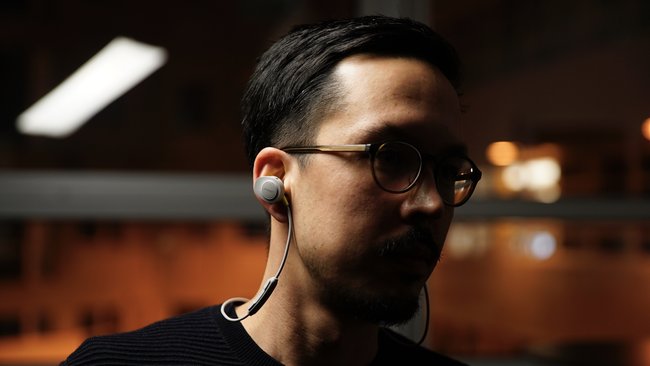Sports headphones with bluetooth test 2022
Listening to music and doing sports at the same time: A great combo that puts you in a good mood and boosts motivation. However, the question arises: “Which sports headphones should I buy?”. We explain what to look out for and introduce you to the best Bluetooth models for athletes.
Contents
True wireless: Beats Fit Pro
Relatively new, relatively expensive, but also pretty good: The Beats Fit Pro (see on Amazon) are ideal for all kinds of sports thanks to their compact design and flexible silicone wings. I can shake my head as I will, they always stay in place. Even a headstand was no problem with them – I just deduce from this that they are even suitable for yoga (I don’t have the experience there).
The manufacturer emphasizes that the Beats Fit Pro are compatible with Apple and Android – but I find that iPhone users have a slight advantage because only they can enjoy 3D sound with dynamic head tracking, for example. Conclusion: My personal sports headphones favorite and – apart from sporty aspects – also the currently best alternative to the popular AirPods Pro.
Advantages:
- Consistently designed for sport with a secure fit
- Useful functions (ANC, 3D audio etc.)
Disadvantages:
- Full range of functions only on iOS, some features are missing on Android
- Relatively large transport case
You can also see some impressions of the Beats Fit Pro in this video:
Great sound, but with a cable: Bose Soundsport Wireless
yes the model Bose Soundsport Wireless (view at Amazon) has been around for a few years now. Nevertheless, the headphones with a neckband (a cable that you put around your neck) are still worth a look. Unlike models that have just been released, the Bose no longer has to prove itself, as more than 24,000 predominantly positive customer reviews on Amazon show (as of March 2022). It passed this large-scale “long-term test” with flying colors.
What excited me during the test back then: Only a few headphones sound as rich and powerful as the Bose Soundsport Wireless – with the right music, that drives the whole body. The battery life (up to 6 hours per charge) is below average by today’s standards and the sheer size of the two cases also seems a bit strange. But why should that interfere with the evening jog, especially if the price is right? Take a look at this classic.
Advantages:
- Powerful sound
- Secure fit and high wearing comfort
Disadvantages:
- Very voluminous shells, protruding clearly from the ears
- Battery life only up to 6 hours per charge
Ears free thanks to bone conduction: Shokz OpenRun Pro
the Shokz OpenRun Pro (check it out on Amazon) are unlike any other headphones. The manufacturer, formerly known as “AfterShokz”, has occupied a niche with its bone conduction technology, which is particularly interesting for outdoor activities. Instead of clogging the ear canals, the ears remain free. The OpenRun Pro is worn in a similar way to glasses (but backwards), and most of the sound transmission takes place directly via the cheekbones. You can always hear whether cars are approaching or a bicycle is ringing.
This works amazingly well, the sound quality is more than sufficient, at least for the secondary sound reinforcement, and provides motivation when running. Compared to conventional in-ears, bass-heavy kick drums lack the power, but you are compensated for with a particularly airy and light wearing comfort.
Advantages:
- More intense perception of surroundings
- Multipoint Bluetooth
- Fast battery charging
- Dust and waterproof according to IP55
- Comfortable to wear but…
Disadvantages:
- … Impractical design
- Weak bass sound
- No intuitive operation
- Packaging not up to date
More on this in our detailed test report by Sarah:
Headphones and sports: you should pay attention to this when buying
The most important basic rule: Doing sports and wearing headphones should always be done with safety in mind. Both the athlete and his environment should under no circumstances be put in danger. Concrete example: If you ride a bike with headphones on, you could not hear other vehicles (danger to yourself) or be so distracted by the music that you lose concentration on other road users (danger to others).
Fixed seat: Sport means movement, so the headphones have to fit well. In-ear models usually have an advantage here, as they are stuck firmly in the ear canal – provided they are properly seated. Some models are also provided with hooks or wings on the earpieces, so that the hold on the ear is reinforced. Headband headphones (over-ear/on-ear) have to have a strong contact pressure and at the same time be light in weight in order to hold up comparably well.
Pros and cons of cables: With in-ear headphones, there are models with a cable or neckband that connects both earphones. Since Apple’s AirPods came out, the true wireless earbuds category, i.e. two separate earphones, without any cables, has also become increasingly popular. It is not possible to say in general which solution is fundamentally better. Neckband Bluetooth headphones tend to have longer battery life and are less likely to be lost. True wireless earbuds could (individually) fly out of the ear with a jagged movement and may then be lost. The following applies: Where there is no cable, you cannot get stuck somewhere with a cable either.
Water and dust resistance: So-called IP codes provide information on whether a gadget is protected against water, dust and sweat. Such properties are usually also advertised by the manufacturer and can be clearly seen from the packaging of the headphones alone. Conversely, this means that if headphones are not labeled “waterproof” or “waterproof”, then they are not recommended for a sweaty sport.
Battery life, sound and design: How many hours a pair of headphones lasts is less important for sports headphones than it is for “travel headphones” (e.g. Sony WH-1000XM4). Above all, it is important that the headphones last the intended duration of the activity (e.g. 2 hours of jogging). An excessively strong bass can be annoying when listening to music, but it’s not that bad during running training. When it comes to design, you can make “compromises” because it’s not about looks, it’s about functionality. In the review of the Bose Soundsport Free, for example, we complained that the bulky housing protruded from the ears – but that’s ultimately a matter of taste and doesn’t matter much to the ambitious athlete.
Headphones for sports: trying them on helps with the purchase decision
In the end, the only way to find out whether a pair of headphones really fits well and whether it suits the intended sport is to try it out beforehand. Because what is firmly in one user’s ear and easily participates in a somersault, the other user falls out with a slight shake of the head. Therefore: Ask in the shop whether you can try out the models or, if in doubt, make use of your right of return with the online retailer.





